- Back to Home »
- Tourism »
- Tourism Objects of Jakarta
3.12.2015
Jakarta

Jakarta is the capital city of the Republic of Indonesia, a country composed of more than 13,000 islands with a population of over 180 million. Comprising more than 300 ethnic groups speaking 200 different languages, the Indonesia population exhibits marked diversity in its linguistic, culture, and religious traditions. As the Capital City, Jakarta is a melting pot of representatives from each of these ethnic groups. Jakarta is a special territory enjoying the status of a province, consisting of Greater Jakarta, covering of 637.44 square km area. Located on the northern coast of West Java, it is the center of government, commerce and industry and has an extensive communications network with the rest of the country and the outside world. Strategically positioned in the archipelago, the city is also the principal gateway to the rest of Indonesia. From the Capital City, sophisticated land, air, and sea transport is available to the rest of the country and beyond.
Jakarta is one of Indonesia's designated tourist areas. It is a gateway to other tourist destinations in Indonesia and is equipped with all the means of modern transportation by air, sea, rail, or by land. It has the largest and most modern airport in the country, the most important harbor in Indonesia and is well connected by rail of good roads to other destinations in Java, Sumatra, and Bali. As Indonesia's main gateway, Soekarno-Hatta International Airport serves a growing number of international airlines and domestic flights. Jakarta is a city of contrasts; the traditional and the modern, the rich and the poor, the sacral and the worldly, often stand side by side in this bustling metropolis. Even its population gathered from all those diverse ethnic and cultural groups, which compose Indonesia, are constantly juxtaposed present reminder of the national motto; Unity in Diversity.
Finding its origin in the small early 16th century harbor town of Sunda Kelapa, Jakarta's founding is thought to have taken place on June 22, 1527, when it was re-named Jayakarta, meaning Glorious Victory by the conquering Prince Fatahillah from neighboring Cirebon. The Dutch East Indies Company, which captured the town and destroyed it in 1619, changed its name into Batavia and made it the center for the expansion of their power in the East Indies. Shortly after the outbreak of World War II, Batavia fell into the hands of the invading Japanese forces that changed the name of the city into 'Jakarta' as a gesture aimed at winning the sympathy of the Indonesians. The name was retained after Indonesia achieved national independence after the war's end.
The ethnic of Jakarta called "Orang Betawi" speaks Betawi Malay, spoken as well in the surrounding towns such as Bekasi and Tangerang. Their language, Betawi Malay, has two variations: conventional Betawi Malay, spoken by elder people and bred in Jakarta, and modern Jakarta Malay, a slang form spoken by the younger generation and migrants.
Tourism Objects Of Jakarta
National Monument
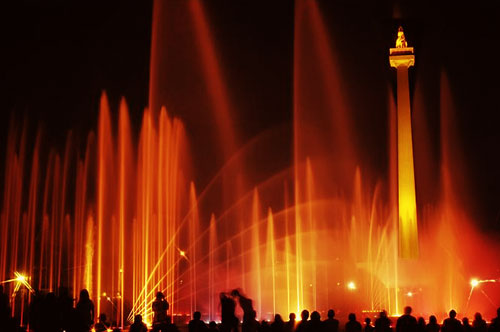
The National Monument, or "Monas" as it is popularly called, is one of the monuments built during the Sukarno era of fierce nationalism. The top of the National Monument (Monas) is Freedom Square. It stands for the people's determination to achieve freedom and the crowning of their efforts in the Proclamation of Independence in August 1945. The 137-meter tall marble obelisk is topped with a flame coated with 35 kg of gold. The base houses a historical museum and a hall for meditations. The monument is open to the public and upon request the lift can carry visitors to the top, which offers a bird's eye view on the city and the sea.
Go early to beat the crowds and the haze. It is easy for the less physically able as lifts take visitors to the top. The diorama exhibition in the basement gives such a distorted view of Indonesian history - thanks to the dictator Suharto wanting to brainwash the nation - it's amusing. This imposing obelisk is Jakarta's most famous landmark. Construction started in 1961 under President Soekarno but was not completed until 1975, under President Soeharto. The monument houses a couple of museums. The Freedom Hall depicts Indonesia's struggle for independence through a series of dioramas, whereas the Hall of Contemplation displays the original Declaration of Independence document and a recording of the speech. An elevator takes one to the observation platform, which commands a bird's-eye view of the cityscape.
Beautiful Indonesia in Miniature Park (TMII)
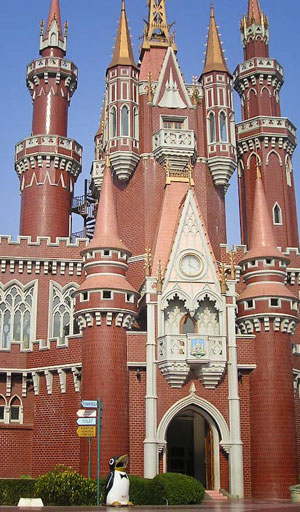
Taman Mini Indonesia Indah (Beautiful Indonesia in Miniature Park) is Indonesia's answer to every visitor's prayer to see the magnificent archipelago in just one day. An extensive park to get a glimpse of the diverseness of the Indonesian archipelago, it represents Indonesia's 27 provinces and their outstanding characteristics, reflected most strikingly in the exact regional architecture of the province. An extensive theme park set in over 100 hectares on the outskirts of Jakarta; the All Indonesian islands are realistically reproduced in miniature in a central lake and around the lakes, there are pavilions. Each pavilions is representative of each province firm the traditional architectural style in miniature to a wonderful display of cultural items and exhibits. The park's centerpiece is a beautiful artificial lake. The complex was the brainchild of Madam Tien Soeharto, the late Indonesian first lady.
It also has its own orchid garden in which hundreds of Indonesian orchid varieties are grown. There is also a bird park with a walk-in aviary, a fauna museum and recreational grounds with a swimming pool and restaurants. The special interest here at Taman Mini is the Museum Indonesia. A richly decorated building in Balinese architecture, it houses contemporary arts, crafts and traditional costumes from the different regions of the country.
Cultural performances, events, and even local delicacies from the provinces are prepared regularly, especially during weekends and holidays, to showcase Indonesia's rich cultural heritage. The park is open seven days a week, giving guests ample time to explore and enjoy the sights. And if a day tour is not enough, visitors can spend the night at the 'Desa Wisata' or 'Wisata Remaja' serviced accommodations.
"Theater Imax Keong Emas" (Golden Snail Theater)
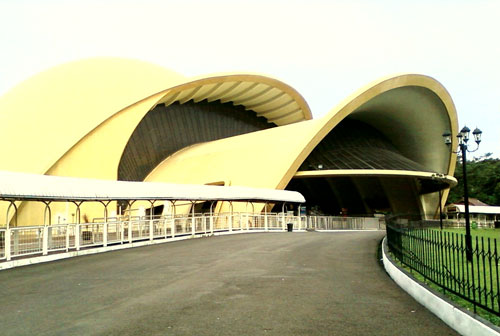
Keong Emas means Golden Snail. This theater is easily recognized because the roof takes the shape a golden snail. Located in the Taman Mini, the Imax Theater presents "Beautiful Indonesia" on a gigantic screen using the latest Imax system. The theater was first open to the public on April 20, 1984 and it's enormous screen, using the latest Imax System, has been listed in the Guinness Book of Records as the largest screen in the world during the 1985, 1986, 1987, 1988, 1989, 1990 and 1991 edition. This theater is located in East Jakarta, in the complex area of Taman Mini Indonesia Indah (The Miniature of Indonesia Park), which was also built on the initiative of Madame Tien Suharto.
The Keong Emas Imax Theater has become one of the most popular attractions where lots of tourists, domestic and foreign, young and adult, especially groups of children visit. Besides the large dimension of the screen, the theater also has another feature that makes it attractive: the films are displayed in three dimensions (3D). The subjects of the movies on display are mainly "Beautiful Indonesia" related to its culture and art, as well as its environment and the places around Indonesia. All in all, the main purpose of the movies is to highlight Indonesia's beauty on the big screen and attract tourism. This location is open from 11.00 am - 5.00 pm.
Jaya Ancol Dreamland (Taman Impian Jaya Ancol)
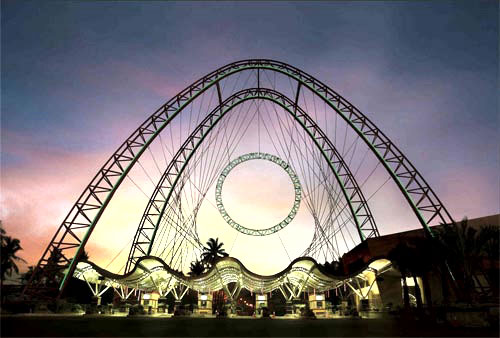
Taman Impian Jaya Ancol, an amusement park in north Jakarta, Indonesia, is one of the most attractive places serving the densely populated city of Jakarta. It has all the adventures people crave for; Sea World, Fantasy World, Atlantis Water Adventure and Marina Beach. This is Jakarta's largest and most popular recreation park. It is built on reclaimed beach land at the Bay of Jakarta, having, sea and freshwater aquariums, swimming pools, an artificial lagoon for fishing, boating, bowling, an assortment of nightclubs, restaurants, a steam-bath and massage parlors. The Ancol complex includes a Marina, Dunia Fantasi (Fantasy Land), a golf course, hotels and a drive-in theater. The "Pasar Seni" or art market has a varied collection of Indonesian handicraft, paintings and souvenirs on sale. At a nearby open-air theater art performances are held using the local dialect.
Inside the Ancol Dreamland, there is Ancol Art Market, it is outdoor art market likely recreational place where we will be most tempted to purchase something. Items include antiques, handicrafts, painting, potters, and knickknacks. With many of the artisans working on site, it is a paradise for souvenir hunters and art lovers. This colorful open-air market located in the Ancol Amusement Park provides the unique experience of not only buying quality Indonesian arts and craft, but also a chance to see and meet the artisans at work. We can watch puppet makers, wood-carvers, painters, and many other craft makers from throughout the archipelago cheerfully working on their creations. At this art and handicraft market, visitors get to watch Indonesian artists creating their masterpieces. Hundreds of artists from all over the country congregate here to exhibit their work, making the spot a fascinating place for tourists and art connoisseurs. We can even get a portrait of our self-done. Both traditional and modern art and crafts are on display, including paintings, sculptures, traditional Indonesian wayang kulit (leather puppets), gemstone jewelry and many other artistic products. Art performances are frequently held at the Art Market (Pasar Seni) inside the Jaya Ancol Dreamland on Jakarta's beach. They normally range from wayang kulit shadow plays to folk dances and modern drama. This location is open Monday to Saturday, from 2 p.m. to 9 p.m.; Sunday, from 10 a.m. to 9 p.m.
Sea World
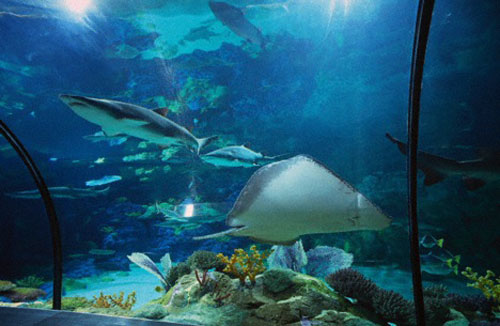
Inside the Ancol Dreamland complex, Sea World is a high tech modern huge aquarium exhibiting the special and diverse tropical marine life found throughout the Indonesian waters. Stroll through Freshwater World and Micro world, see beautiful tropical fish and corral reefs, and get friendly with marine life at the Touch pool. A theater screens movies about the underwater world and a necessity is the Antasena Tunnel, a walk-through acrylic tube that gives first hand experience of life under the sea. This giant aquarium proudly introduces visitors to more than 4,000 fish and sharks from 300 species. Sea World has great many attractions to its credit; it has a Dolphin Show that is quite popular and a gallery, which showcases many of sea creatures from all over the world. Some times people find it better in comparison to Sentosa Island, one of the most popular destinations in Singapore.
Come and enjoy the deep-sea panorama while strolling through an 80-meter tunnel. The fascinating creatures live in some 500 million liters of seawater and are fed three times a day (some hand-fed). The attraction also features a theater, which plays three educational films in English and Bahasa Indonesia. Open Monday to Saturday, from 2 p.m. to 9 p.m.; Sunday, from 10 a.m. to 9 p.m.
Fantasy Land

Dunia Fantasi or 'Fantasy World' / 'Fantasy Land' is a fun and theme park designed to entertain the visitors into the fascinating worlds of modern science and technology. A recent addition to Jakarta's growing recreation facilities is the Fantasy Land, a 9.5 hectares (23.75 acres) entertainment park located inside the Ancol Dreamland. Planned to eventually become a part of a 200-hectares (500-acres) park designed to usher the visitors into the fascinating world of modern science and technology, the present facility takes them on an imaginative tour of Old Jakarta, Africa, America, Indonesia, Europe, Asia and the Palace of Dolls. Each of the areas is designed to give the visitor a feel of the region he is visiting through features and architecture of the area at a certain period of its history and by the use of animated puppets in the Palace of Dolls.
This colossal recreational resort faces the enchanting Jakarta Bay. Its prime attraction is Fantasyland, an amusement park that keeps children, especially, entertained the entire day. Fantasy world is the host of many of the amusement rides and the most popular of them is a roller coaster ride called Halilinter. The park has other themes also. Art buffs and tourists who search of souvenirs should visit Pasar Seni art and handicraft market. Others might like to check out Sea World (a giant aquarium) for an educational tour on marine life or Ancol Water Park for yet more fun. The Ancol Marina operates as the gateway to the neighboring Thousand Islands. The facilities take visitors on imagination tours of Africa, America and Indonesia through some breath taking games. The park also offers a number of restaurants and souvenir shops.
Marina Jaya Ancol

This is the port to reach Pulau Seribu (Thousand Islands) in the Bay of Jakarta, as well as the center for marine sports ad recreation. This is a special port for yachts, motor and sailboats, and the scattered islands in the Bay of Jakarta. This is also the place for marine recreation and sports where each facility is amply provided; water cycles, canoes, sail boats, fishing gear and many others. Stalls along the beach serve drinks and snacks while tents are available for sunbathers and sea lovers.
Ancol Marina is the most usual departure point, speed boats leaving regularly to whisk us away from the city heat to the cool, palm fringed beaches of paradise. However chartering a boat is also possible for anyone with a more adventurous spirit. Jet skies canoes, sail boats wind surfing and waterskiing are all to be found, along with all kinds of fishing gear we may need for hire. Numerous stalls along the beach serve drinks and snacks while tents are available for sunbathers and sea-lovers.
Pelangi Island, a small island that located about 70 kilometers from Marina Ancol or about one and a half hours by speedboat, is a near Sepa Island and Pantara Island. The similarities of these beautiful islands are that they have sandy beaches and sit in the middle of a clean blue ocean. Pelangi Island had thronged by Italian and Japanese tourists. Presently, thanks to the domestic tourists and expatriates, the island economy is sustained.
Sunda Kelapa

Sunda Kelapa, better known as Pasar Ikan (meaning fish market) is located at the mouth of the Ciliwung River. The fish catch of the day was auctioned in the early morning at the old fish market. The street leading to it was lined with shops selling all sorts of shells, dehydrated turtles, lobsters and mostly everything the seafarer might need. This 500-year-old harbor area was a vital link to markets of the outside world for the 15th century kingdom of Pajajaran. It was formerly the harbor town of Sunda Kelapa where the Portuguese traded with the Hindu Kingdom of Pajajaran in the early 16th century. Since than this port has belonged to the portuguese and Dutch.
Dutch domination of Jakarta and the rest of Indonesia began from this area, whereas the remnants of Kasteel Batavia, an old fort and trading post of the Dutch East Indies Company can still be seen now. Sunda Kelapa is at present a fisherman's wharf and an inter island port. Tall-misted Bugis schooners from South Sulawesi anchoring there offer a picturesque scene. They belong to one of the last-fleets of sailboats in the world and still ply the seas between the islands, as they did centuries ago, carrying merchandise.
Tough little remains of bustling old Sunda Kelapa except the name, the harbor is still one of the most important calls for sailing vessels from all over Indonesia. The magnificent and brightly painted Makassar schooner called Pinisi is still an important means of transporting goods to and from the outer islands. This is one of the finest sights in Jakarta.
Wander around the old Sunda Kelapa port, watching gangs of sinew-stretched coolies smoking pungent clove-laced cigarettes unload cargos of timber, coal and spices from stunning wooden schooners. Hire a dugout canoe and paddlers and enjoy the waterside scenery. The boats also go to the nearby old fish market, which can be reached easily by foot from the port and is free to enter. Work starts here at 3am and it's essential to arrive by 6am to see the best of the action.
T.I.M (Taman Ismail Marzuki) Art Center
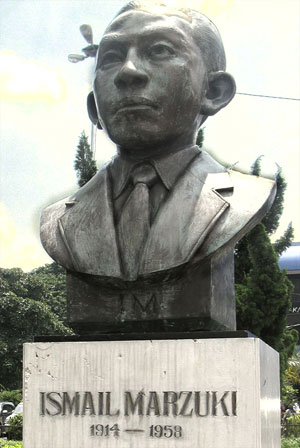
Jakarta is overflowing with hip clubs and bars catering to all tastes. But if we want a snapshot of Jakarta's current artistic pulse head to Taman Ismail Marzuki in Cikini. The center of Arts in Jakarta, Taman Ismail Marzuki, also known as TIM, is a complex located on Cikini Raya Street 37, Jakarta. Those who are looking for traditional and contemporary arts might find this place useful. This complex acquired its name from the great Indonesian musician, Ismail Marzuki, whose statue guards the entrance gate. It hosts the Institut Kesenian Jakarta (Jakarta Institute for the Arts) and Jakarta Platenarium. The arts institute is the only one of its kind in Indonesia and the first local college entirely dedicated to the training of performing and visual arts. There are modern, state-of-the-art theatres and cinemas, more traditional auditoriums, street performers and a cornucopia of restaurants and bars offering basic but tasty food and drink from all over Indonesia. The patrons range from the young, trendy, keen-to-be-seen set to bohemian artistes debating the latest trends.
The focal point of cultural activities in Jakarta is the Jakarta Art Center, known as Taman Ismail Marzuki or TIM in short. It is said to be the largest of its kind in Southeast Asia and consists of exhibition halls, theaters, an academy of arts, an archives building and a planetarium. A monthly programmed of events, available at hotel counters, includes exhibitions, plays, musical and poetry recitals, dance performances, folk art and drama from the various regions of Indonesia. Facilities include an indoor and outdoor theater, exhibition halls, two art galleries and a cineplex.
Pulau Seribu (Thousand Island)

Thousand Isles near Jakarta has been a favorite destination for ages. Paradiso, containing four island's Kahyangan (formerly known as Cipir), Bidadari (used to be called Sakit), Onrust and Kelor offer spectacular views of the forest and the sea. The name Paradiso indeed comes from Paradise, for 'Kahyangan' in Indonesian means 'Heaven' in English, and 'Bidadari' means 'Angel'. Dotted throughout Jakarta Bay are 120 tropical islands and coral atolls known, rather misleadingly, as the Thousand Islands. This group of islands in the Jakarta Bay offers a heaven away from the bustle of city life. There are golden beaches fringed with coconut palms. The surrounding waters are a paradise for skin divers. They are filled with a myriad of tropical fish, which live among the multicolored corals. The islands can be reached from Tanjung Priok or Pasar Ikan (Sunda Kelapa) by ferry or by chartered boat. Some of the islands in this group developed for tourism are Pulau Bidadari, Pulau Anyer, Pulau Laki and Pulau Putri. Pulau Tanjung near Putri has an airstrip. There are cabins for hire, having fresh water on Pulau Air and Pulau Bidadari only. The Pulau Putri Paradise Co. has developed Pulau Putri, Pulau Melintang, Pulau Petondan and Pulau Papa Theo as a holiday resort with cottages, restaurants, diving and sailing facilities. With a total population of only 13,000 people, the bay contains a sprinkling of the 'virgin islands', although the majorities are inhabited. Many are privately owned. The departure point to this cluster of individual paradises is the Ancol Marina, where further information on travel arrangements can be found. Daliy boats to most islands, departing at 08.00 and 09.00.
This chain of several dozen islets immediately north of the city is administratively part of Jakarta and usually an oasis of quiet. Speedboats take visitors to basic but comfortable hotels an hour or so from the city, where one can snorkel, dive or just lie on a white sand beach with a friendly turtle.
Ragunan Zoo

Ragunan zoo in South Jakarta is a popular place to visit, particularly during holidays. Jakarta's zoo is situated in the suburb of Ragunan in the southern part of the city. Laid out in a lush tropical setting, such indigenous animals as the Komodo lizard, tapir, anoa, Java tiger, banteng, wild ox and brightly colored birds are given ample room to be in this green foliage. The new primates are centered at Ragunan Zoo. It's a world-class facility and guaranteed to entertain and educate both the young and young at heart.
According to its history, Taman Margasatwa Ragunan, or Ragunan Wildlife Reserve, was first set up by a Dutch flora and fauna lovers organization. The organization, the Vereneging Plantenen Dierentuin at Batavia, set up the park on a 10-hectare plot of land in Cikini Raya Street 2, South Jakarta in 1864. The park, Plantenen Dierentuin, was moved to the present location in 1964 to accommodate the city's development plan. In the new location, the park was given a 10-hectare plot of land, but now it occupies 135 hectares of land. This zoo was located at Cikini until 1964, when the site was no longer large enough to accommodate its rapid expansion. Reopened in 1966, the zoo now exhibits 550 species of tropical plants and animals from Indonesia and around the world. Endangered species bred here include the Sumatran tiger, Komodo dragon, dwarf buffalo and bird of paradise.
Now, the zoo is busy preparing a 10-hectare enclosure, which was described by the director as the largest and most luxurious one in the world, for the new guests. The spot is ideal for family excursions and picnics amid the abundant flora. Come during weekdays when it is less crowded. Open dally from 8.00 a.m. to 6.00 p.m. The zoological garden is most crowded on Sunday and public holidays.
Central Museum

The Batavian Society of the Arts and Sciences was established on this site in 1778, by U.M.C. Rademacher under the auspices of the Batavia Association of Arts and Sciences, it offers historical, prehistorically, archaeological and ethnographic aspects of Indonesia through its extensive collection of artifacts and relics which date as far back as to the Stone Age. It has one of the most complete collections of bronzes and ceramics dating back to the Han, Tang and Ming Dynasties. The Museum has one of the finest numismatic collections in the world, including cloth and money, which was used on several islands until recently. The religious art section is filled with statuary and sculpture salvaged from sites of Hindu, Buddhist and Islamic edifices. Its collection of cultural instruments, household utensils, arts and crafts provide an introduction to the life of the various ethnic groups, which populate Indonesia. This museum is popularly known as Gedung Gajah or "Elephant Building" because of the stone elephant offered by King Chulalongkorn of Thailand in 1871, placed on the front lawn of the building.
Due to its rapid growth, the building was transformed into a museum in 1862. As well as being excellent displays of everything Indonesian, leather puppet shows, called Wayang Kulit, are performed every second and last Saturday night of the month at the Central Museum in Jakarta.
National Museum

The Museum is situated on Merdeka Barat Street. Currently the National Museum houses collections of 109,342 objects under the categories of prehistory, archaeology, ethnography, numismatics-heraldic, geography and historical relics. In 1994, the museum started with is expansion project. The new building, constructed in the same architectural style as the old, comprises an arena for theatrical performances and more spaces for exhibitions. The museum curators provide detailed information and guidance on collections-related subjects during working hours. The daily activities at the National Museum include collecting, caring for and protecting collections and providing information on the museum and its collections to visitors and the public at large. The Indonesian Heritage Society (HIS) voluntarily assists the museum in handling the inventory of the collections.
The museum's Conservation and Restoration Division is dedicated to conserving and restoring the collected objects in order to protect them from possible damages and loss. The staffs also take preventive measures against possible damages or loss through manual, alarm and control system. This Museum is open from 8.30 am to 2.30 pm on Tuesday, Wednesday, Thursday and Sunday, from 8.30 am to 11.30 am on Friday, and from 8.30 am to 1.30 pm on Saturday. The Museum is closed on Monday and Public Holidays.
This museum is also has supporting with such tourism facilities. A small gift shop located in the entrance hall has the same opening hours as the rest of The Museum. It offers a selection of books, postcards and reproductions of various exhibits. The front courtyard can accommodate cars and tour buses. Visitors are kindly asked to refrain from smoking, eating and drinking in all areas of the Museum, and are prohibited from touching the exhibits.
Jakarta History Museum

Located in the historic Old Jakarta Kota area, Taman Fatahillah square offers three of the city's most interesting museums. Once the heart of the colonial administration in the 18th century the square underwent a major restoration in the 1970's. A fountain in the middle of square once as the main water supply for the former colonial capital. The Portuguese cannon on the north side of the square is reportedly an impressive font of fertility. Jakarta History Museum is the one displaying the history of the development of the City of Jakarta, both the events and the community, from the prehistory until these present days. This museum is located in a building of cultural property which in the past known as Stadhuis, the City Hall of Batavia. As written on an inscription of the Museum collection, the building was constructed in 1707 by the city government of Batavia during the period of VOC and Governor General Abraham van Riebeeck inaugurated it in 1710. This building is located in front of a park, which in the past was known as Stadhuisplein, the City Hall Park, and now it is called Taman Fatahillah.
Since 1970, the surroundings of Taman Fatahillah have been declared as Cultural Property and it was totally preserved. This effort was the beginning of the development of the historical area of the City of Jakarta, carried out by the Government of DKI Jakarta. The Museum of History of Jakarta was inaugurated on 30 March 1974 for being the center for collection, conservation and research for all kinds of objects of cultural property related to the history of the City of Jakarta and at the same time becomes a center for education, study and recreation for the community. Due the very long course of the history of Jakarta, the collection of this Museum are highly varied in shape and consist of objects being the heritage of the prehistorical period until the beginning of the 20th century. There are another replicas of the Tugu Inscription from the age of Great King Purnawarman, forming evidence that the center of the Kingdom of Tarumanegara was located in around the seaport of Tanjung Priok. Further, a map of the 16th century and the replica of the Padrao monument of the Portuguese represent the historical evidence of the age of Sunda Kelapa Harbor. The period of Jayakarta is the beginning of the establishment of the City bronze cannon and through various drawings and maps of the 17th century. Furniture collection of Betawi style from the 17th, 18th and 19th century is the richest collection and belongs to the most complete one in the world. This collection is very interesting since the association reflects of the community of Batavia City with various cultural elements from Europe, especially Dutch, China, India and Indonesia.
Shadow Puppets Museum
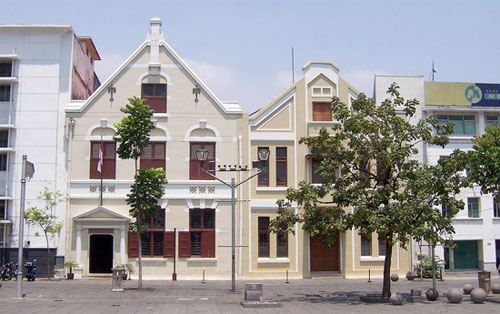
This artistic building stay at Pintu Besar Utara Street 27, West Jakarta, was built in 1912, previously as land of a church, which was built in 1640 under the name of De Oude Hollandsche Kerk (The Old Dutch Church). In 1732 it was renovated and its name was changed into De Nieuwe Hollandsche Kerk (The New Dutch Church). The church building was once totally destroyed by an earthquake. Bataviasche Genootschap van Kunsten en Wetenschappen (Batavia Society of Arts and Sciences), that was an institution dealing with science and Indonesian culture bought this building.
The institution then delivered this building to the Stichting Oud Batavia (Old Batavia Foundation) and on 22 December 1939. It was made a museum under the name of Oude Bataviasche Museum (Old Batavia Museum). In 1957 this building was delivered to Lembaga Kebudayaan Indonesia (Institute of Indonesian Culture) and on 17 September 1962 it was delivered to the Ministry of Education and Culture of the Republic of Indonesia, which later was delivered to the DKI Jakarta Administration on 23 June 1968 to be made Shadow Puppet Museum, which inauguration was carried out on 13 August 1975.
Shadow Puppet (commonly known as wayang) in Indonesia, especially on Java Island, was originally a product of the Royal Court culture. It was first used as an instrument of worship to the ancestors, and after the Hindu culture entered Indonesia iaround the 5th century, it developed shifting of values. The world of Indonesian shadow puppet got characteristically influence especially in term of story, like the Ramayana (the Story of Rama) and Mahabharata (the Great Bharata), making the form of presentation keep on changing and with wider range in performance and in the theme of the story. In its later development the Indonesian shadow puppet had become such tradition, that it has been capable to hold out in the supporting community consisting of various elements. Visitors of this Museum are invited to know various characters, attitude and behavior of the story from various regions through the performance of shadow puppet that has weight of high value in our culture and viewing a number of collections of shadow puppet like wayang kulit, wayang golek, patung wayang, topeng wayang, wayang beber, wayang kaca, gamelan (traditional music instrument set) as well as wayang paintings.
This Museum also displays various collections of wayang and dolls from friendly countries like Malaysia, Thailand, Suriname, China, Vietnam, France, India and Cambodia. It is not merely to be an object for recreation, study for students/ devotee can be carried out in this Museum, and this Museum even can be used as venue for training, documentation center and research on shadow puppet, and it can be used as inter-regional and international media on cultural knowledge. To support its existence, in this Museum wayang staging and attraction of wayang making are periodically organized.
Ancient Inscription Museum

Ancient Inscription Museum is located at Tanah Abang Street 1, Central Jakarta. The piece of land of former Dutch cemetery called Kebon Jahe Kober has been arranged to be a shaded and green garden with various kinds of tropical plants grown on it, and has become a place of intensive supports for both artistic and historical values. This land was designed as cemetery for the Dutch, especially for officials and important prominent figures.
After Indonesia gained its independence, this land was still used for the public, especially by Christian people. Since 1975 Kebon Jahe cemetery was closed, and by seeing the existing potentials, preservation and rearrangement of the selected inscriptions and gravestones were performed on that land of 1,3 ha. On 7 July 1977 the DKI Jakarta Governor Ali Sadikin, inaugurated pat of the land of the former Kebon Jahe cemetery to be an Inscription Museum. Knowing the inscription would mean to know the works of talented designers, painters and sculptors cast as a materialization of deep expression of the people who gave the order or the users, because as if inscription was able to talk on what we need to know.
This Museum displays gravestones from various Dutch names and prominent figures like Major General J. H. R. Kohler, Dr. W.F. Stuterheim, Dr. F. Roll, Pieter Erberveld and others. There is a row of other names like Olivia M. Raffles, Miss Riboet, Soe Hok Gie and others who was berried or moved to this location since the 17th century until the 1900s.
Fine Art and Ceramic Museum

Fine Arts and Ceramic Building Museum was built in 1870. At the beginning the building was used as Dutch Judiciary Institution or Raad Van Justitie, then when Japan colonized Indonesia and the fight for Indonesia freedom occurred the building was used as military dormitory. Furthermore it was used as West Jakarta Mayor's Office in 1967. In 1968 until 1975 it was used as office of DKI Jakarta Museum and History Official. On Agust 20 th 1976 it was announced officially as Fine Arts Gallery Building and now become Fine Arts and Ceramic Museum.
This museum has around 400 fine arts, which consist of many different techniques and materials, such as sculpture, graphic, wood totem, sketch, and painting batik. Among those collection there are some masterpieces, collections that useful for the art history in Indonesia. They are "Revolution Bride" painting by Hendra Gunawan, "Lebak Regent" painting by Raden Saleh. "Mother Give Sick" painting by Dullah, "Tritura Paramilitary Troops" painting by S. Sudjojono, and "Self-Potrait" painting by Affandi. Traditional classical sculpture from Bali, magical and symbolic wood totem by Tjokot and families, Totem and wood sculpture by modern artists, such as G. Sidharta, Oesman Effendi. Then followed by academy graduate artists creation, like Popo Iskandar, Achmad Sadali, Srihadi S. Fajar Sidik, Kusnadi, Rusli, Nashar, Zaini, Amang Rahman, Suprapto, Irsam. Mulyadi W, Abas Alibasyah, Amri Yahya, AS Budiono, Barli, Sudjana Kerton and many other artists from various regions. There are also plenty of ceramic collections in this museum, consist of local and also foriegn ceramic. the local ceramic comes from Aceh, Medan, Palembang, Lampung, Jakarta, Bandung, Purwakarta, Yogyakarta, Malang, Bali, Lombok, etc.
This Museum has also Majapahit ceramic from the 14 th century, which show beatiful extraordinary characteristic and have history value with various shapes and functions. The foreign ceramic of various shapes, characteristics, functions, and styles from China, Japan, Vietnam, Thailand, Dutch, Germany, and Middle East. The greatest numbers are from China, especially from Ching and Ming Dinasty. Fine Art's and Ceramic Museum has specific souvenir for visitors, like post cards, fine art's book, handicraft, sketch, fan, cute sculpture, etc. The Museum is open daily from 9 am to 3 pm on Tuesday to Sunday. The Museum is closed on Monday and Public Holidays.
1945 Struggle for Freedom Museum

1945 Struggle for Freedom Museum is located at Menteng Raya Street 31, Central Jakarta. In 1938, a Dutch businessman named LC Schomper, built a hotel called Schomper, I at Menteng Area. The hotel was built as a place to spend nights for high officials of the Nederland, foreign Entrepreneurs, and high officials of local government.
During the colonization of the Japanese Empire in Indonesia youth and it was turned into a boarding house and Education center for Indonesian Youth in order to learn nationalism. Soekarno (1st Indonesian President), Mohammad Hatta (1st Indonesian Vice President), Adam Malik Chaerul Saleh and many other youth generations of Indonesia are involved in the educations process inside. The name of the Hotel Schomper 1 Hotel then turned into Gedung Menteng 31 Building). As time went by, the Gedung Menteng 31 was used for many purposes. It was once used as office of Ministry of Manpower arrangement, National Boards of the Generation of 1945, and Jointly Secretariat of Nation Works Organization (secretariat Bersama Golongan Karya) - Embrio the GOLKAR Party.
After the building was renovated and repaired Gedung Menteng 31 was officially established as Museum Joang 45 on August 19, 1974, by former President Soeharto and former governor of Jakarta Ali Sadikin. The name, Museum Joang 45' is chosen as the building has played great role on the Independence if Indonesia and could become a site for the inheritance process of invaluable struggle values in 1945. The Museum is open from 8.00 am to 3.00 pm on Monday to Friday.
Maritime Museum
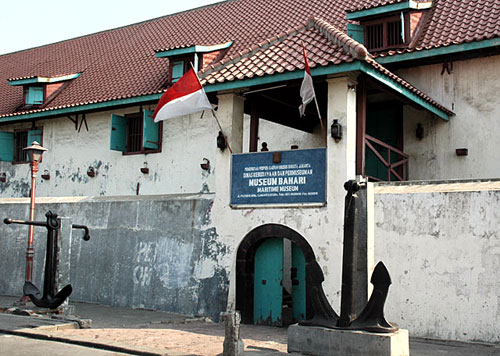
Maritime Museum is located at Pasar Ikan, 1 North Jakarta. Initially these building served as warehouse for storing spices. The Dutch East Hindia Company started the constructions in 1652 and expanded in the years later. In 1976 the premises were handed over to the municipal government of Jakarta and preparation were started to convert them into a museum. The maritime museum was officially opened on July 7th, 1997. The objective of this museum is to converse, maintain, protect and expose the Indonesia maritime and fishery tradition. A variety of traditional Indonesia boats with their very specific shapes, equipment and decorative trimmings reflect a high-standard maritime heritage. Apart from these props, there also miniatures of modern ships on display. Navigational tools, anchor, the model of light house, antique canons and many more items form part of the museum's collection.
Indonesia is an archipelago country with a territorial extent of 5,1 million square kilometers. Out of that extent, 3,1 million sq. Km or 60 % are waters. This geographical condition, of course, contains various kinds maritime culture. It may be true when later there has been a poem contained in the song of the Indonesian children saying Our Ancestors W ere Seamen. The Maritime Museum is the only one in Indonesia presenting maritime specific theme. The building used for it was the former warehouse for storing spices which in the past known as Westzijdsche Pakhuizen. The construction was done in three stages; it was commenced in 1652 until 1774.During the Japanese occupation (World War II) these warehouses were still used for storing Japanese owned goods for war purposes. This Museum, inaugurated by the Governor of DKI Jakarta, Ali Sadikin, in 1977, has now around 1670 collections from various maritime aspects, displayed in the forms of natural and cultural heritages.
Those Collections are, for example, traditional boats (originals and models) found in the Nusantara archipelago like Bugis boat, Phinisi (Bugis cargo boat), Pandekawang, miniature of Alut Pasa boat from Kalimantan and Warship from Maluku called Kora-Kora. Sea biota, sea archaeology, fisherman equipments, fishery anthropology and folklore, history of shipping relations between Nusantara and the Netherlands, Maritime tourism, information on the Navy, paintings of maritime prominent figures and other important maritime information. In the context of its development, the Maritime Museum often holds collaboration with the related Foreign Embassies and Governmental Agencies.










Your information that you provide is very helpful, it helps to know more about the place
BalasHapusHello, AVENTURA is a loan lender who gives life time loan opportunity, Do you need an urgent loan to clear your debts or you need a capital loan to improve your business? We are helping people in financial difficulties who has been rejected by banks and other financial agencies? search no more as we are here to make all your financial problems a thing of the past. We loan funds out to individuals in need of financial assistance at a rate of 1% interest. we render reliable and beneficiary assistance. For application and more information send replies to the following...
BalasHapusE-mail address: aventuraloan@protonmail.com
Whatsapps: +12184618467